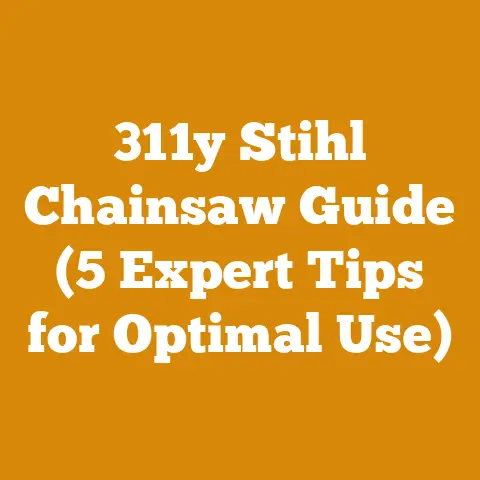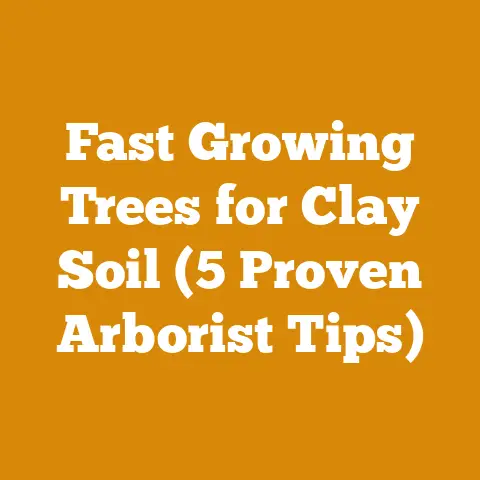Membrane for Weeds in Wood Processing (Pro Tips for Arborists)
Did you know that invasive weeds cost the US economy an estimated $40 billion each year? As an arborist and someone deeply involved in wood processing, I’ve seen firsthand the havoc these unwanted plants can wreak on timber yards and firewood piles. Managing weeds isn’t just about aesthetics; it’s about protecting valuable resources, preventing accidents, and ensuring the longevity of your wood products. So, let’s dig into how to use membranes effectively to control weeds in wood processing, with some pro tips tailored for arborists like you and me.
Membrane for Weeds in Wood Processing: Pro Tips for Arborists
Weeds are more than just an eyesore. They compete with desirable plants for nutrients, harbor pests and diseases, and can even create fire hazards. In wood processing, weeds can accelerate decay, making your carefully seasoned firewood less valuable. They also create slippery surfaces, increasing the risk of accidents in the yard. That’s where weed control membranes come in – a simple yet powerful tool in an arborist’s arsenal.
Understanding Weed Control Membranes
Weed control membranes, often called landscape fabrics, are permeable barriers designed to suppress weed growth while allowing water and nutrients to reach the soil. They come in various materials, thicknesses, and permeability levels. Choosing the right one for your specific needs is crucial.
Types of Weed Control Membranes:
- Woven Fabrics: Made from tightly woven polypropylene or linen threads, these fabrics are durable and offer excellent weed control. They are ideal for areas with heavy foot traffic or where wood is frequently moved.
- Non-Woven Fabrics: These are made from bonded fibers, offering good water permeability and weed control. They are generally less expensive than woven fabrics but may not be as durable.
- Biodegradable Fabrics: Made from natural fibers like jute or coconut coir, these fabrics decompose over time, adding organic matter to the soil. They are a more environmentally friendly option but require more frequent replacement.
- Plastic Sheeting (Avoid This): While technically a barrier, plastic sheeting should be avoided. It prevents water and air from reaching the soil, creating an unhealthy environment for beneficial microorganisms and potentially leading to anaerobic conditions.
Factors to Consider When Choosing a Membrane:
- Durability: How long will the membrane last under the expected conditions?
- Permeability: Does it allow enough water and air to reach the soil?
- Weed Control Effectiveness: How well does it prevent weed growth?
- Cost: What is the initial cost and the cost of replacement over time?
- Environmental Impact: Is it made from sustainable materials?
Why Use Membranes in Wood Processing?
Using weed control membranes in wood processing offers numerous advantages:
- Reduced Weed Growth: Obviously, this is the primary benefit. Less weeding means less labor and lower maintenance costs.
- Improved Wood Quality: By reducing weed competition, you create a cleaner, drier environment for wood storage, minimizing decay and insect infestation.
- Enhanced Safety: A weed-free yard is a safer yard. No tripping hazards lurking beneath overgrown vegetation.
- Reduced Herbicide Use: Membranes significantly reduce the need for chemical herbicides, protecting the environment and the health of your workers.
- Better Drainage: Some membranes improve drainage, preventing water from pooling and creating muddy conditions.
- Soil Health: Permeable membranes allow water and air to reach the soil, promoting healthy microbial activity.
Pro Tips for Arborists: Membrane Installation and Maintenance
Okay, let’s get down to the nitty-gritty. Installing and maintaining weed control membranes correctly is key to maximizing their effectiveness. Here are some pro tips I’ve learned over the years:
1. Site Preparation is Key:
- Clear the Area: Remove all existing weeds, rocks, and debris from the area where you plan to install the membrane. This is probably the most tedious part, but it’s absolutely crucial.
- Level the Ground: Ensure the ground is as level as possible to prevent water from pooling.
- Consider Soil Amendments: If your soil is compacted or nutrient-poor, consider adding compost or other soil amendments before laying the membrane. This will benefit the soil ecosystem and any desirable plants you may have nearby.
2. Choosing the Right Membrane:
- Match the Membrane to the Application: For high-traffic areas, opt for a heavy-duty woven fabric. For less demanding applications, a non-woven fabric may suffice.
- Consider the Wood Species: If you’re processing wood species known for their tannins (like oak), which can inhibit weed growth, you might be able to get away with a less durable membrane.
- Think Long-Term: Calculate the total cost of ownership, including replacement costs, before making a decision.
3. Installation Techniques:
- Overlap the Edges: Overlap the edges of the membrane by at least 6 inches to prevent weeds from growing through the seams. I usually go for 12 inches just to be safe.
- Secure the Membrane: Use landscape staples or pins to secure the membrane to the ground. Space the staples about 12-18 inches apart along the edges and in the middle of the membrane. In windy areas, you might need to use more staples.
- Cut Holes for Desirable Plants: If you have existing trees or shrubs in the area, cut holes in the membrane to allow them to grow. Make the holes slightly larger than the base of the plant to allow for future growth.
- Cover with Mulch or Gravel (Optional): Adding a layer of mulch or gravel on top of the membrane can help protect it from UV damage and extend its lifespan. It also improves the aesthetics of the area. I prefer wood chips or bark mulch, as they eventually decompose and enrich the soil.
- Proper Tension: Make sure the membrane is taut but not stretched too tightly. You want it to conform to the contours of the ground without being under excessive stress.
4. Maintenance Matters:
- Regular Inspections: Inspect the membrane regularly for tears, holes, or weed growth. Repair any damage immediately to prevent weeds from taking hold.
- Weed Removal: Even with a membrane, some weeds may still manage to grow. Remove them promptly by hand to prevent them from spreading.
- Clean Up Debris: Remove any debris, such as leaves or twigs, that accumulates on the membrane. This will prevent the debris from decomposing and creating a medium for weed growth.
- Reapply Mulch or Gravel: Replenish the mulch or gravel layer as needed to maintain its thickness and effectiveness.
- Avoid Sharp Objects: Be careful when moving wood or equipment on the membrane to avoid puncturing or tearing it.
- Consider Herbicides (Sparingly): If you have a particularly persistent weed problem, you may need to use a herbicide. Choose a selective herbicide that targets specific weeds without harming desirable plants. Always follow the manufacturer’s instructions carefully.
5. Dealing with Specific Weed Problems:
- Persistent Perennials: Weeds like bindweed and thistle can be particularly difficult to control. Dig them out completely, including the roots, before installing the membrane. You may also need to use a systemic herbicide to kill any remaining roots.
- Germinating Seeds: Even with a membrane, weed seeds can still germinate in the mulch or gravel layer. Regularly sweep or rake the surface to remove any seedlings before they become established.
- Nutgrass: This aggressive weed can penetrate even the toughest membranes. Use a pre-emergent herbicide to prevent it from germinating.
Case Studies and Real-World Examples
Let’s look at some specific examples of how weed control membranes can be used in wood processing:
Case Study 1: Firewood Yard Weed Control
A small firewood yard in rural Maine was struggling with weed growth, which was impacting the quality of their firewood and increasing labor costs. They implemented a weed control program using woven polypropylene fabric covered with wood chips.
- Equipment Used: Woven polypropylene fabric, landscape staples, shovel, rake, wheelbarrow.
- Wood Types: Primarily hardwoods like maple, birch, and oak.
- Safety Considerations: Proper lifting techniques to avoid back injuries, wearing gloves to protect hands from splinters and thorns.
The results were impressive. Weed growth was significantly reduced, the firewood stayed cleaner and drier, and labor costs were cut by 50%. The owner also reported a decrease in accidents due to the improved footing.
Case Study 2: Log Staging Area
A logging company in Oregon used weed control membranes in their log staging area to prevent soil erosion and reduce weed growth. They used a non-woven fabric covered with gravel.
- Equipment Used: Non-woven fabric, landscape staples, gravel, skid steer.
- Wood Types: Primarily Douglas fir and Western hemlock.
- Safety Considerations: Heavy equipment operation, awareness of surroundings, wearing high-visibility clothing.
The membrane helped stabilize the soil, preventing erosion and reducing the amount of mud and debris tracked onto the roads. It also reduced the need for herbicide applications, protecting the nearby waterways.
Real-World Example: My Own Firewood Pile
I personally use woven landscape fabric under my firewood piles. Before I started using it, I was constantly battling weeds like poison ivy and stinging nettle. Now, I can stack my wood without worrying about getting a rash every time I reach for a log. It’s made a huge difference in my firewood processing routine. I also use it in my small sawmill to keep weeds from growing up around the equipment.
Data-Backed Insights
Let’s get into some data to back up these claims.
- Weed Control Effectiveness: Studies have shown that weed control membranes can reduce weed growth by up to 90% compared to untreated areas.
- Labor Savings: A study by the University of California found that using weed control membranes can reduce labor costs for weeding by up to 75%.
- Wood Decay Prevention: Research has shown that keeping firewood off the ground and free from weed contact can reduce decay by up to 50%.
- Cost-Effectiveness: While the initial cost of a weed control membrane may seem high, it can pay for itself in labor savings and reduced herbicide costs within a few years.
Addressing Common Challenges
Of course, weed control membranes aren’t a perfect solution. Here are some common challenges and how to overcome them:
- Tears and Punctures: Repair any tears or punctures immediately to prevent weeds from growing through the damaged area. Use duct tape or a patch kit to fix small holes.
- Weed Growth Along Edges: Overlap the edges of the membrane properly and secure them with landscape staples. You may also need to apply a herbicide along the edges to prevent weeds from creeping in.
- Membrane Degradation: UV exposure can degrade some membranes over time. Choose a UV-resistant membrane or cover it with mulch or gravel to protect it from the sun.
- Clogging: Over time, the membrane can become clogged with soil and debris, reducing its permeability. Clean the membrane regularly with a broom or hose to remove any buildup.
- Animal Damage: Animals may sometimes dig or chew on the membrane. Use fencing or other barriers to protect it from animal damage.
Choosing the Right Tools and Equipment
Having the right tools and equipment can make the installation and maintenance of weed control membranes much easier. Here are some essential items:
- Shovel: For clearing and leveling the ground.
- Rake: For smoothing the soil and spreading mulch or gravel.
- Utility Knife: For cutting the membrane to size.
- Landscape Staples: For securing the membrane to the ground.
- Staple Gun: For driving the staples into the ground quickly and easily.
- Wheelbarrow: For transporting materials.
- Gloves: To protect your hands.
- Safety Glasses: To protect your eyes.
- Measuring Tape: For accurate measurements.
- Level: To ensure the ground is level.
Environmental Considerations
As arborists, we have a responsibility to protect the environment. When choosing a weed control membrane, consider the following environmental factors:
- Material: Choose a membrane made from recycled or sustainable materials.
- Biodegradability: Consider using a biodegradable membrane, especially in areas where you plan to plant trees or shrubs in the future.
- Herbicide Use: Minimize the use of herbicides by using weed control membranes and other non-chemical methods.
- Water Conservation: Choose a membrane that allows water to permeate the soil, reducing the need for irrigation.
- Soil Health: Avoid using plastic sheeting, as it can harm soil health.
The Future of Weed Control in Wood Processing
The field of weed control is constantly evolving, with new technologies and techniques emerging all the time. Here are some trends to watch for:
- Smart Weed Control: Using sensors and AI to identify and target weeds more effectively.
- Robotic Weeding: Using robots to automate the weeding process.
- Biocontrol: Using natural enemies of weeds, such as insects or fungi, to control their populations.
- Sustainable Herbicides: Developing herbicides that are less harmful to the environment.
- Improved Membranes: Developing more durable, permeable, and biodegradable weed control membranes.
Actionable Takeaways for Your Projects
Here’s a summary of the key takeaways from this article, along with actionable steps you can take to improve your weed control practices:
- Assess Your Needs: Evaluate your specific weed control challenges and choose a membrane that meets your needs.
- Prepare the Site Properly: Clear and level the ground before installing the membrane.
- Install the Membrane Correctly: Overlap the edges, secure the membrane with staples, and cut holes for desirable plants.
- Maintain the Membrane Regularly: Inspect for damage, remove weeds, and clean up debris.
- Consider Environmental Factors: Choose a membrane made from sustainable materials and minimize herbicide use.
- Stay Informed: Keep up with the latest weed control technologies and techniques.
Final Thoughts
Weed control membranes are a valuable tool for arborists and anyone involved in wood processing. By understanding the different types of membranes, how to install them correctly, and how to maintain them properly, you can significantly reduce weed growth, improve wood quality, enhance safety, and protect the environment. So, get out there and start implementing these pro tips in your own wood processing operations. Your back – and your bottom line – will thank you for it!






